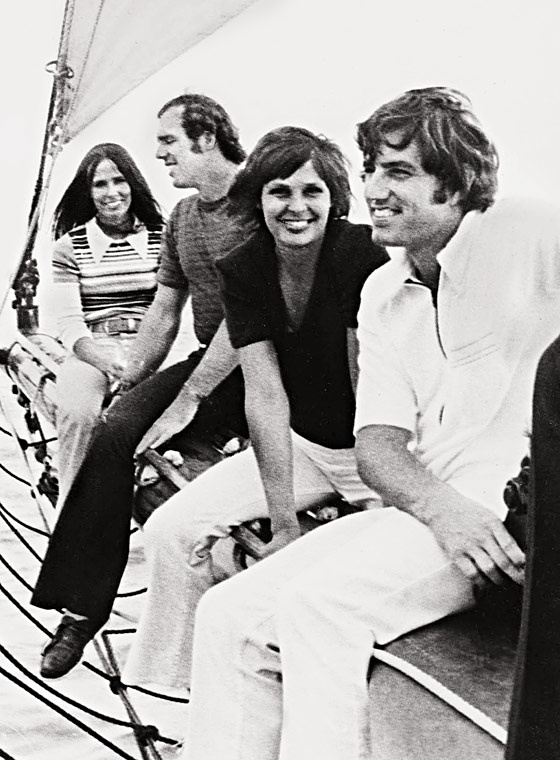 |
The couples before the Trade. Mike Kekich (far right) swapped wife Susanne for Marilyn Peterson (far left). Fritz Peterson swapped wife Marilyn for Susanne Kekich.
(Photo: Marty Lederhandler/AP) |
It is hard to keep up with the politicians, but the New York Sports Sex-Scandal Hall of Fame has an impressive roster, back to when Babe Ruth reputedly missed half the 1925 season with the clap. Patrick Ewing, Mike Tyson, Lawrence Taylor, David Cone, Isiah Thomas, and Marv Albert are just a few of the city’s best-known sports figures to splat across the back page on accusations ranging from statutory rape to bull-pen masturbation and cross-dressing toupee loss.
However, even if no center-field monument will commemorate it, New York’s all-time oddest sports sex scandal came to light during spring training in 1973. That was when two Yankees pitchers, Fritz Peterson and Mike Kekich, 40 percent of the team’s starting rotation, called a press conference to inform mind-boggled newsmen that they had traded families. This included wives, children, and pets.
“Don’t make anything sordid out of this,” said the 31-year-old Peterson, a twenty-game winner in 1970 who was then living with Kekich’s wife, Susanne, in Franklin Lakes, New Jersey. The 27-year-old Kekich agreed. “Don’t say this was wife-swapping, because it wasn’t,” Kekich said. “We didn’t swap wives, we swapped lives.”
“It was hard to know whether to laugh or cry,” says Phil Pepe, Daily News Yankees beat writer at the time. “George Steinbrenner bought the team weeks before, but mostly he walked around pointing at guys whose hair he thought was too long. Ralph Houk, the manager, sat there smoking a cigar, trying to keep a straight face.”
Thirty-eight years later, despite holding steady as ESPN.com’s “sixth most shocking moment in baseball history,” the Peterson-Kekich “Trade” has been largely regarded as a curio of the game’s wacky period immediately preceding free agency, a time that included Charlie Finley’s mule and Dock Ellis’s supposedly pitching a no-hitter while under the influence of LSD.
I was thinking about the Trade as I made my way to Yankee Stadium one recent Friday night. Once upon a time, this was one of the great rushes of city life—the IRT lurching up from the tunnel to reveal the fortress stadium, a green swath of outfield grass fleeting by the window as the train pulled into the 161st Street station. Now, with the Big Ballpark’s $1.5 billion simulacrum hauled up River Avenue, the first thing you see is a multilevel parking lot where they charge suburban fans $35 per car.
It was in this frame of reference that I recalled a series of articles I’d read in the paper about how Ben Affleck was preparing a long-delayed film project based on the Peterson-Kekich affair. Affleck was working on the script with his brother, Casey, “Page Six” said. Matt Damon was rumored to be involved. This raised local hackles. “Where do Boston dweebs get off making a movie about a Yankee anything?” one talk-show caller growled. In an attempt to make nice, Affleck said on MTV that he had nothing against the current Yankees players, who seemed “like good guys.” However, as for the Yankees “as an institution,” Affleck felt nothing but “disdain” and “contempt,” to which he added, “guys (bleep)ing each others’ wives—that’s those Yankees.”
As someone whose trade-unionist grandfather cursed the Yanks as the team of the plutocrats, I understood why a film about the Trade would appeal to those less-than-enthralled by the pinstripes. The Yankees won a numbing fourteen pennants in sixteen years, from 1949 to 1964, but by the early seventies, baseball in the already burning Bronx was moribund. With the Savage Skulls in the street and Reggie Jackson still a distant wet dream, the Yanks were mired in the “Horace Clarke Era”—named for the .256-hitting second-baseman known for bailing out on the double play. In 1972, the year before Steinbrenner bought the greatest franchise in sports for the E. J. Korvette markdown of $10 million (!), a mere 966,328 people, the fewest since 1945, came to the rusting hulk that Ruth built.
Into this desultory environs arrived Fritz Peterson and Mike Kekich, an odd couple of left-handers with Beatles cuts and paisley shirts. Peterson was the funny one, the clubhouse cutup. He put talcum powder in Joe Pepitone’s hair dryer and printed up fake newspapers with stories about how the Yankees plane had crashed and he was the only survivor. Once, the right-handed Thurman Munson sent away for a holster for his .357 Magnum; Peterson switched the order to a left-handed holster. When Munson sent away for a refund, Peterson got in touch with the company and asked them to send Munson a booklet on how to draw a gun left-handed. On the mound, however, few had better control. In his twenty-win 1970 season, Peterson pitched 260 innings and walked only 40 batters, a remarkable ratio. Of pitchers making a requisite number of starts at the old stadium, Peterson has the lowest ERA—better than Whitey Ford, Lefty Gomez, and Red Ruffing.

